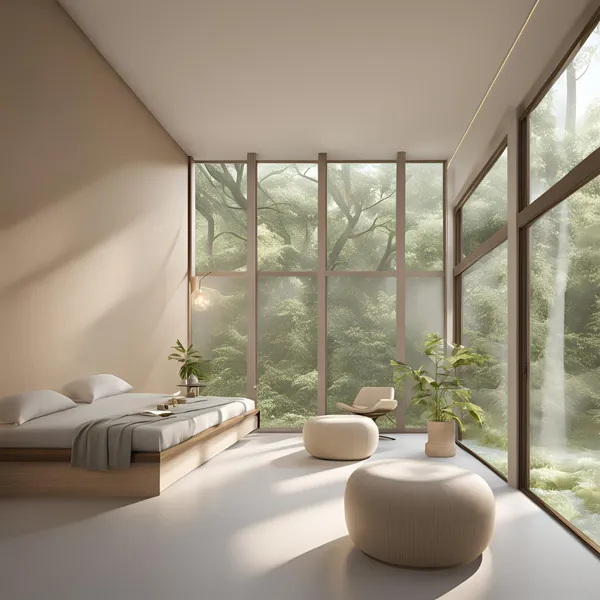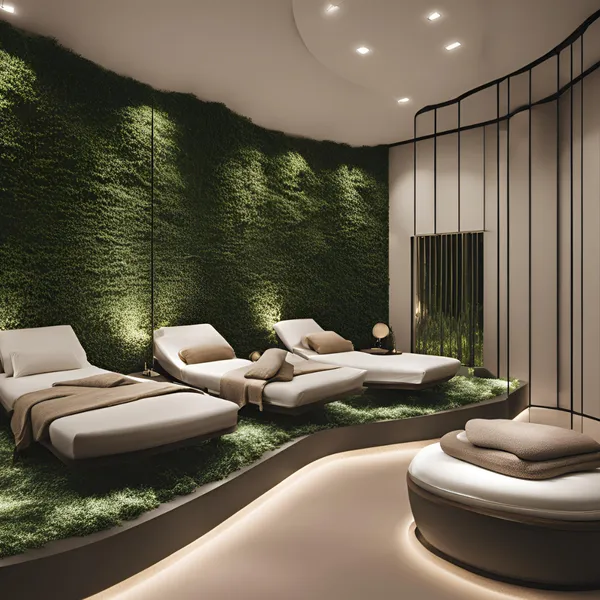Interior design for wellness rooms is an exciting idea that shapes organizations and workplaces to have an environment that supports rest and destressing.
With increasing awareness of the need for balance in our daily lives, wellness room trends have gained momentum. This guide will explore critical elements of interior design that make a wellness room truly functional and serene.
What Is a Wellness Room?
A wellness room is a specific area in a house or workplace intended to improve people’s physical, psychological, and spiritual conditions.
It can be used for meditation, yoga, or stretching and can be a nice relaxing spot after work or any day after work.
Unlike traditional living areas, wellness rooms are carefully crafted to promote peace and tranquility.
Critical Principles of Interior Design for Wellness Rooms

1. Functionality
Depending on the goal set for this space, it should be able to meet that goal efficiently. Whether it is Yoga, meditation, or simple mindfulness exercises, the designated room has to be practical and multi-purposeful.
The agency should decide on an apparent focal activity. For instance, the meditation rooms may have padded sitting mats and very little paraphernalia, while the yoga rooms need some floor space.
Ensure ease of movement. Refrain from overcrowded spaces since this often creates stress flows and slows movement.
2. Natural Elements
It is easy to style a wellness room to reflect calm by incorporating items from nature.
- Natural light: Best install large windows or skylights or use a curtain close to the natural light for better light.
- Plants: Bring ferns, succulents, or peace lilies to purify air and increase tranquility.
- Earthy materials: These materials give an earthy feel to furniture and floors and include wood, stone, and bamboo.
3. Color Psychology
Colors affect emotions significantly; thus, it is essential to choose the right colors.
- Neutral tones: Pale colors, which include off-whites, creams, or even beige, will give your room a serene background.
- Calming colors: Dulled browns, greens, and light shades on the NT are associated with calmness and quietness.
- Accent colors: A little earthy brown or warm gold could go a long way in infusing energy into it.
4. Lighting
This aspect of light demonstrates the techniques to adapt the lighting to provide the right atmosphere in a wellness room.
- Layered lighting: Overhead, task, and ambient light sources should provide flexibility in the light environment.
- Dimmable lights: Brightness settings may be changed, so the mood can also change.
- Warm light bulbs: Do not use white light sources because they are too harsh; use red or orange instead.
Essential Design Features for Wellness Rooms

1. Comfortable Flooring
They are needed to be comfortable while being practical and easy to use on the flooring.
- Yoga mats or rugs: Provider a smooth and slippery surface.
- Cork flooring: A sustainable shoe for activities for which one does not wear shoes.
- Low-maintenance materials: Choose an economical type of floor that can be easily washed, for instance, vinyl or sealed wood.
2. Noise Reduction
Noise reduction is essential to achieve a quiet environment.
- Acoustic panels: These minimize outside noises as well as reverberation.
- Thick rugs or carpets: These muffle sound and bring extra body warmth.
- White noise machines: Although not necessary, a good one is the ability to minimize or filter background noise.
3. Storage Solutions
This gives them the organizational space they need without compromising the budget and clean lines look.
- Built-in shelves: keep fitness balls, mats, straps, blocks, blankets, or books.
- Decorative baskets: Fabric or woven baskets give the home a natural aura.
- Multi-purpose furniture: Storage benches are space savers.
4. Seating
Seating is compact, as activities such as meditation will require comfortable sitting.
- Floor cushions: Select soft chairs that are close to the floor.
- Chairs with lumbar support: Perfect for anyone who spends their days sitting at a desk and trying to practice mindfulness at work.
- Recliners or bean bags: Incorporate some new features and address the end users who mainly visit this site to relax.
Common Themes and Styles for a Wellness Room

Selecting a single concept helps make the space look unified. Below are some popular styles:
1. Minimalist Style
It is straightforward and without many frills or embellishments.
Choosing and setting the color of more neutral colors, the natural material design, simple and smooth lines.
Accents are to be functional and purposeful.
2. Bohemian Style
Embrace textures of utmost luxuriousness, such as macramé, layered rugs, and embroidery on cushions.
Use warm and earth tones and exotic patterns.
Include swing-plant and furniture-premium from the past.
3. Modern Zen Style
Try to hit the middle ground where there is a lot of maximalism but only a little stuff.
She was decorated with the dearest natural Japanese motifs: shoji screens, bamboo ornaments, and water decorations.
They should diffuse gentle lighting and use natural shades of color for the apparel.
4. Scandinavian Style
It means that one has to harmoniously blend warmth into the functional components of the architectural design.
Avoid dark woods and heavy textiles; preferably, use light-colored wood furniture and beige furniture like fluffy rugs.
Integrating Wellness Concepts into the Development

Meditation Corners
- Seating should be done less conspicuously.
- A small altar or an object that will serve as an attention grabber, like a statue, a candle, or an incense burner.
- Put the corner to fit a window and provide a natural or soothing environment.
Yoga Zones
- It is also essential to ensure enough area on the floor as a person moves around.
- Add a full-length mirror to ensure the correct postures and the other figures are in order.
- Keep straps and bolsters used in the store in baskets or shelves for easy access.
Sensory Areas
- In combination with aromatherapy, diffusers for oils such as lavender or eucalyptus should be placed in the bathroom.
- Bring more fluffy objects like carpets, velour pillows, or silk curtains.
- Dimming or coloring of the currents used as lighting also provides sensory inputs.
Relaxation Nooks
- Place a day bed or lounge chair with soft upholstery on it.
- It is advisable to place a reading light and a couple or three books or magazines.
- Choose dark straps or pellets, thick, smooth curtains, or a canopy for maximum closeness and a specific feeling of being enveloped.
Technology in Wellness Rooms
While wellness rooms focus on unplugging, technology can enhance the experience when used thoughtfully.
- Sound systems: Get the speakers for the guided meditation, nature or calming music, etc.
- Bright lighting: Employ the smart lights; this one has an app that allows one to set the light they want.
- Air purifiers: Reduce mold and mildew and enhance the general air quality as well as the quality of the environment.
Wearable tech: Synchronize fitness or mindfulness watches to set a complete wellness regimen.
Tips for Small Spaces
Even small spaces can be transformed into functional wellness rooms with creative solutions.
1. Multi-Purpose Rooms
Take a small part of the living room, bedroom, or office as a workstation.
Use furniture that may be folded or moved around to ease the area’s changing.
2. Vertical Design
Hangers can be used to suspend planters, shelves, or art pieces to free up floor space.
Install tall mirrors, and they will give the space a much bigger feeling than it is now.
3. Portable Elements
Select mobile chairs and lightweight mats for yoga or use rolling screens.
These add privacy without necessarily blocking the entire view of the central area; use sheer curtains or partitions.
The Role of Sustainability
Also, a wellness room should accommodate the idea of sustainability in its design because well-being encompasses our environment.
- Recycled materials: Furnish with woods that have been recycled or are new pieces created from recycled components.
- Non-toxic paints: Make sure that all surfaces of the walls are painted with low Volatile Organic Compounds (VOCs).
- Energy-efficient lighting: LED lights help to save energy.
- Water-saving features: Recirculating pumps must be incorporated into the fountain systems if a fountain is added.
Final Touches: Accessories for Wellness Rooms
1. Art and Decor
Choose non-figurative paintings or seascapes that will help you relax and bring joy.
Prevent unmaintainable designs that are too crowded or elicit too much motion.
2. Textiles
Throw rugs, curtains, and cushions should be provided in natural fabrics, such as cotton or linen.
Trying layering, especially with fabrics, to create coziness.
3. Scents and Sounds
Hang wind spinners, astringent diffusers, or light-scented tealite burners in strategic locations.
If you appreciate sounds, play wind chimes or put water fountains in your room for soothing sounds and relaxation.
4. Personal Touches
These should be pictures, tickets, receipts, or anything else that will make you feel good as you look at them.
Ensure you develop the best decorations that will uphold the purpose and vision of the place.
Common Mistakes to Avoid
- Overdecorating: Having many items can result in cluttering the interior design atmosphere.
- Ignoring ergonomics: Coziness is essential for relaxation and a positive working process.
- Poor lighting: This is terrible for having bright or too low lighting that interferes with the relaxation experience.
- Lack of storage: This cluttering interferes with the room’s calmness, reducing the general appearance of order in the home.
Benefits of a Wellness Room
Physical Benefits
- It promotes the need to take time to stretch, meditate, or even practice yoga.
- This improves their general body posture as well as increases physical flexibility.
Mental Benefits
- Cuts down stress and anxiety:
- Which enhances concentration and alertness.
Emotional Benefits
- Provides privacy and seclusion at the same time.
- It helps to develop attentiveness and manage one’s emotions.
In conclusion, It is well-known that designing a wellness room is crucial in preserving (or building) one’s holistic health.
Removing the elements of glamor, ostentation, trivialities, nature, practicality, and exquisite design creates a haven that encourages rest.
It may be a big or small, simple room, dull or colorful and artistic; your wellness room should match your requirements. Keep in mind that the primary purpose is to achieve the design of a beautiful room in which one can have a break and recharge his energy.
Take this as a process and have fun achieving a state of tranquility—while sitting comfortably at home.